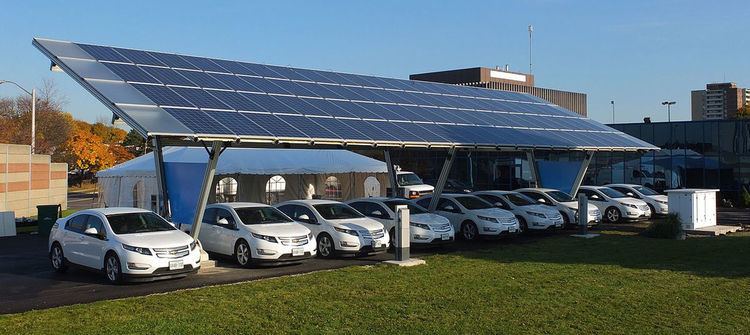 | ||
The long tailpipe is a reference to greenhouse gases that are emitted in the production of electricity used to charge electric vehicles. Plug-in electric vehicles operating in all-electric mode have no emissions (greenhouse gases or otherwise) from the onboard source of power. The long tailpipe claims these emissions are shifted from the vehicle tailpipe to the location of the electrical generation plants. From the point of view of a well-to-wheel assessment, the extent of the actual carbon footprint depends on the fuel and technology used for electricity generation.
Contents
Description
Plug-in electric vehicles operating in all-electric mode do not emit greenhouse gases from the onboard source of power but emissions are shifted to the location of the generation plants. From the point of view of a well-to-wheel assessment, the extent of the actual carbon footprint depends on the fuel and technology used for electricity generation. From the perspective of a full life cycle analysis, the electricity used to recharge the batteries must be generated from renewable or clean sources such as wind, solar, hydroelectric, or nuclear power for PEVs to have almost none or zero well-to-wheel emissions. On the other hand, when PEVs are recharged from coal-fired plants, they usually produce slightly more greenhouse gas emissions than internal combustion engine vehicles and higher than hybrid electric vehicles.
Because plug-in electric vehicles do not produce emissions at the point of operation are often perceived as being environmentally friendlier than vehicles driven through internal combustion. Assessing the validity of that perception is difficult due to the greenhouse gases generated by the power plants that provide the electricity to charge the vehicles' batteries. For example, the New York Times reported that a Nissan Leaf driving in Los Angeles would have the same environmental impact as a gasoline-powered car with79 mpg‑US (3.0 L/100 km; 95 mpg‑imp) compared to the same trip in Denver would only have the equivalent of 33 mpg‑US (7.1 L/100 km; 40 mpg‑imp). The U.S. Department of Energy published a concise description of the problem: "Electric vehicles (EVs) themselves emit no greenhouse gases (GHGs), but substantial emissions can be produced 'upstream' at the electric power plant."
Carbon footprint in selected countries
A study published in the UK in April 2013 assessed the carbon footprint of plug-in electric vehicles in 20 countries. As a baseline the analysis established that manufacturing emissions account for 70 g CO2/km. The study found that in countries with coal-intensive generation, PEVs are no different from conventional petrol-powered vehicles. Among these countries are China, Indonesia, Australia, South Africa and India. A pure electric car in India generates emissions comparable to a 20 mpg‑US (12 L/100 km; 24 mpg‑imp) petrol car. The country ranking was led by Paraguay, where all electricity is produced from hydropower, and Iceland, where electricity production relies on renewable power, mainly hydro and geothermal power. Resulting carbon emissions from an electric car in both countries are 70 g CO2/km, which is equivalent to a 220 mpg‑US (1.1 L/100 km; 260 mpg‑imp) petrol car, and correspond to manufacturing emissions. Next in the ranking are other countries with similar low carbon electricity generation, including Sweden (mostly hydro and nuclear power ), Brazil (mainly hydropower) and France (predominantly nuclear power). Countries ranking in the middle include Japan, Germany, the UK and the United States.
The following table shows the emissions intensity estimated in the study for each of the 20 countries, and the corresponding emissions equivalent in miles per US gallon of a petrol-powered car:
Carbon footprint in the United States
In the case of the United States, the Union of Concerned Scientists (UCS) conducted a study in 2012 to assess average greenhouse gas emissions resulting from charging plug-in car batteries from the perspective of the full life-cycle (well-to-wheel analysis) and according to fuel and technology used to generate electric power by region. The study used the Nissan Leaf all-electric car to establish the analysis baseline, and electric-utility emissions are based on EPA's 2007 estimates. The UCS study expressed the results in terms of miles per gallon instead of the conventional unit of grams of greenhouse gases or carbon dioxide equivalent emissions per year in order to make the results more friendly for consumers. The study found that in areas where electricity is generated from natural gas, nuclear, hydroelectric or renewable sources, the potential of plug-in electric cars to reduce greenhouse emissions is significant. On the other hand, in regions where a high proportion of power is generated from coal, hybrid electric cars produce less CO2 equivalent emissions than plug-in electric cars, and the best fuel efficient gasoline-powered subcompact car produces slightly less emissions than a PEV. In the worst-case scenario, the study estimated that for a region where all energy is generated from coal, a plug-in electric car would emit greenhouse gas emissions equivalent to a gasoline car rated at a combined city/highway driving fuel economy of 30 mpg‑US (7.8 L/100 km; 36 mpg‑imp). In contrast, in a region that is completely reliant on natural gas, the PEV would be equivalent to a gasoline-powered car rated at50 mpg‑US (4.7 L/100 km; 60 mpg‑imp).
The following table shows a representative sample of cities within each of the three categories of emissions intensity used in the UCS study, showing the corresponding miles per gallon equivalent for each city as compared to the greenhouse gas emissions of a gasoline-powered car:
Criticism
The long tailpipe has been the target of criticism, ranging from claims that many estimates are methodologically flawed to estimates that state that electricity generation in the United States will become less carbon-intensive over time. Tesla Motors CEO Elon Musk published his own criticism of the long tailpipe. The extraction and refining of carbon based fuels and its distribution is in itself an energy intensive industry contributing to CO2 emissions. In 2007 U.S. refineries consumed 39353 million kWh, 70769 million lbs of steam and 697593 million cubic feet of Natural Gas. And the refining energy efficiency for gasoline is estimated to be, at best, 87.7%.
